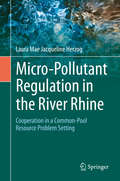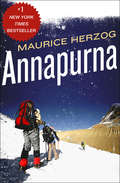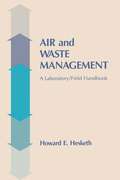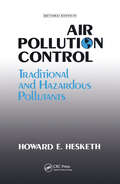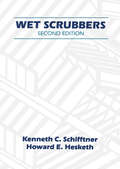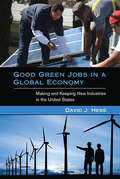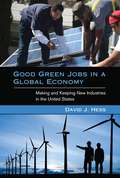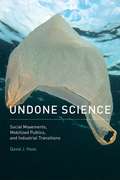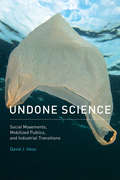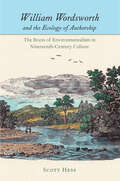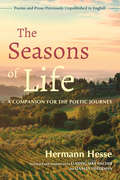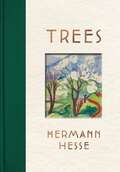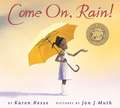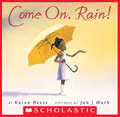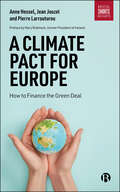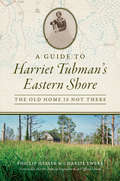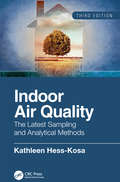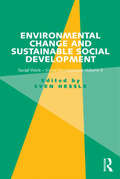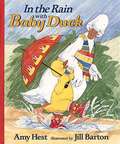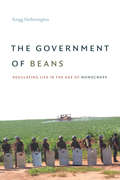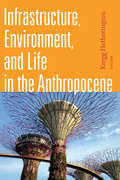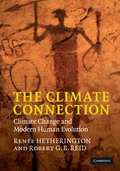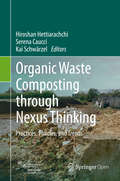- Table View
- List View
Micro-Pollutant Regulation in the River Rhine: Cooperation in a Common-Pool Resource Problem Setting
by Laura Mae HerzogThis book investigates how actors organize in order to solve a water quality problem. Research on the use of environmental resources has mainly focused on the circumstances needed for users to self-organize or to maintain an already sustainable way of resource use. Few studies have investigated the reasons why actors start to cooperate when they are faced with an environmental problem. Actor networks in three regions of the Rhine catchment area are scrutinized regarding a) actors’ cooperation pattern when managing an environmental problem; and b) the factors that trigger actors in a common-pool resource situation to initiate cooperation. Water quality policy is analysed in two European countries – Germany and Luxembourg – and one non-European country - Switzerland –, providing an overview of the distinctive measures applied in these regions aiming to tackle the water quality problem of micro-pollutants in river surface water. Applying the social-ecological system framework (SESF) devised by E. Ostrom and her colleagues and Social Network Analysis (SNA), the current book combines qualitative and quantitative methods to answer the question of why actors cooperate in the management process of an environmental problem like water pollution.
Annapurna: The First Conquest of an 8,000-Meter Peak (Lyons Press Ser.)
by Maurice HerzogOne of Sports Illustrated&’s Top 100 Sports Books of All Time: A gripping firsthand account of one of the most daring climbing expeditions in history. #1 New York Times Bestseller Annapurna I is the name given to the 8,100-meter mountain that ranks among the most forbidding in the Himalayan chain. Dangerous not just for its extreme height but for a long and treacherous approach, its summit proved unreachable until 1950, when a group of French mountaineers made a mad dash for its peak. They became the first men to accomplish the feat, doing so without oxygen tanks or any of the modern equipment that contemporary climbers use. The adventure nearly cost them their lives. Maurice Herzog dictated this firsthand account of the remarkable trek from a hospital bed as he recovered from injuries sustained during the climb. An instant bestseller, it remains one of the most famous mountaineering books of all time, and an enduring testament to the power of the human spirit.
Air and Waste Management: A Laboratory and Field Handbook
by Howard D. HeskethThis manual will serve a useful function in training and giving experience to environmental scientists at all levels. Included in this manual are explanatory materials, exercises and experiments. These are intended as training guides. The users of this manual will find it possible to use simple equipment and naturally occurring events to construct some of the needed equipment but may also find it necessary to use commercially available equipment with some of the procedures.
Air Pollution Control: Traditional Hazardous Pollutants, Revised Edition
by Howard D. HeskethSince the first edition was printed in 1991, there have only been minor changes in air regulations. The opposing "trenches" used by environmental regulation proponents have deepened as each side increases their database. Agencies and environmental groups have backed off a little in issues such as bubble policies and enforcement time tables. This has made it extremely difficult for equipment vendors to anticipate industry requirements. Overall, the current market projections are not very favorable for the new equipment suppliers. In contrast, the service organizations are seeing increasing need for their help in areas such as dispersion modeling, troubleshooting and testing. Existing systems are being improved upon to keep them in operation. There remains a continuous need for up-to-date references and training materials to serve these needs, and it is for this purpose this revised edition is dedicated.
Wet Scrubbers
by Howard D. HeskethA basic technical book on the design and application of gas cleaning technologies that use liquids, first published in the 1980's and used by plant and environmental engineers, regulatory personnel, and others concerned with air pollution. The second edition enlarges the discussion on the theory of
Good Green Jobs in a Global Economy: Making and Keeping New Industries in the United States (Urban and Industrial Environments)
by David J. HessAn examination of the politics of green jobs that foresees a potential ideological shift away from neoliberalism toward “developmentalism.”Good Green Jobs in a Global Economy is the first book to explore the broad implications of the convergence of industrial and environnmental policy in the United States. Under the banner of “green jobs,” clean energy industries and labor, environmental, and antipoverty organizations have forged “blue-green” alliances and achieved some policy victories, most notably at the state and local levels. In this book, David Hess explores the politics of green energy and green jobs, linking the prospect of a green transition to tectonic shifts in the global economy. He argues that the relative decline in U.S. economic power sets the stage for an ideological shift, away from neoliberalism and toward “developmentalism,” an ideology characterized by a more defensive posture with respect to trade and a more active industrial policy.After describing federal green energy initiatives in the first two years of the Obama administration, Hess turns his attention to the state and local levels, examining demand-side and supply-side support for green industry and local small business. He analyzes the successes and failures of green coalitions and the partisan patterns of support for green energy reform. This new piecemeal green industrial policy, Hess argues, signals a fundamental challenge to anti-interventionist beliefs about the relationship between the government and the economy.
Good Green Jobs in a Global Economy
by David J. HessGood Green Jobs in a Global Economy is the first book to explore the broad implications of the convergence of industrial and environnmental policy in the United States. Under the banner of "green jobs," clean energy industries and labor, environmental, and antipoverty organizations have forged "blue-green" alliances and achieved some policy victories, most notably at the state and local levels. In this book, David Hess explores the politics of green energy and green jobs, linking the prospect of a green transition to tectonic shifts in the global economy. He argues that the relative decline in U. S. economic power sets the stage for an ideological shift, away from neoliberalism and toward "developmentalism," an ideology characterized by a more defensive posture with respect to trade and a more active industrial policy. After describing federal green energy initiatives in the first two years of the Obama administration, Hess turns his attention to the state and local levels, examining demand-side and supply-side support for green industry and local small business. He analyzes the successes and failures of green coalitions and the partisan patterns of support for green energy reform. This new piecemeal green industrial policy, Hess argues, signals a fundamental challenge to anti-interventionist beliefs about the relationship between the government and the economy.
Undone Science: Social Movements, Mobilized Publics, and Industrial Transitions
by David J. HessAs the fields of social movement studies (SMS) and science and technology studies (STS) have diversified in topical focus, they have moved closer to each other. SMS has turned toward the study of nonstate targets and institutionalized repertoires of action, just as STS has turned to expertise and publics. In Undone Science, David Hess argues that a theoretical integration of core concepts in the two fields is now possible, and he presents just such a synthesis. Hess focuses on industrial transition movements -- mobilized counterpublics of activists, advocates, entrepreneurs, and other agents of change -- and examines several areas of common ground between the two fields relevant to these movements. His account reveals the problem of "undone science" -- areas of research potentially valuable to the goals of industrial transition movements that have been systematically ignored. Each chapter begins with a problem in SMS, discusses the relevant STS literature, describes new concepts and findings that have emerged, and offers applications to examples that range from nanotechnology and climate science denialism to conflicts based on race, class, and gender. Topics include the epistemic dimension of the political opportunity structure, networks of counterpublic knowledge, and regime resistance in industrial transition.
Undone Science: Social Movements, Mobilized Publics, and Industrial Transitions (The\mit Press Ser.)
by David J. HessA theoretical integration of science and technology studies and social movement studies that finds both common ground and “undone” research.As the fields of social movement studies (SMS) and science and technology studies (STS) have diversified in topical focus, they have moved closer to each other. SMS has turned toward the study of nonstate targets and institutionalized repertoires of action, just as STS has turned to expertise and publics. In Undone Science, David Hess argues that a theoretical integration of core concepts in the two fields is now possible, and he presents just such a synthesis. Hess focuses on industrial transition movements—mobilized counterpublics of activists, advocates, entrepreneurs, and other agents of change—and examines several areas of common ground between the two fields relevant to these movements. His account reveals the problem of “undone science”—areas of research potentially valuable to the goals of industrial transition movements that have been systematically ignored. Each chapter begins with a problem in SMS, discusses the relevant STS literature, describes new concepts and findings that have emerged, and offers applications to examples that range from nanotechnology and climate science denialism to conflicts based on race, class, and gender. Topics include the epistemic dimension of the political opportunity structure, networks of counterpublic knowledge, and regime resistance in industrial transition.
William Wordsworth and the Ecology of Authorship: The Roots of Environmentalism in Nineteenth-Century Culture (Under the Sign of Nature)
by Scott HessIn William Wordsworth and the Ecology of Authorship, Scott Hess explores Wordsworth’s defining role in establishing what he designates as "the ecology of authorship": a primarily middle-class, nineteenth-century conception of nature associated with aesthetics, high culture, individualism, and nation. Instead of viewing Wordsworth as an early ecologist, Hess places him within a context that is largely cultural and aesthetic. The supposedly universal Wordsworthian vision of nature, Hess argues, was in this sense specifically male, middle-class, professional, and culturally elite—factors that continue to shape the environmental movement today.
The Seasons of Life: A Companion for the Poetic Journey--Poems and Prose Previously Unpublished in English
by Hermann HesseA never-before-seen volume of poetry by the preeminent poet laureate Herman Hesse--a beautiful companion to Seasons of the Soul and the author's better-known prose work.Organized into four parts--spring, summer, autumn, and winter--The Seasons of Life relates the transitions in nature to the organic progressions of human life from birth through death. From the mundane to the sublime, the spiritual to the political, and private feeling to expressed opinion, Hesse touches on the range of human experience, inviting the reader to consider both the beauty and what Hesse called the "adversities of life."Beloved by readers as a wise and open friend, Hesse offers in this never-before-translated volume an honest portrayal of a whole life: its lessons and mysteries, its glories and despairs. The poet's voice--so treasured in his novels among a worldwide English-speaking audience--can now be enjoyed through this new translation in the follow-up to Seasons of the Soul.
Trees: An Anthology of Writings and Paintings
by Hermann HesseAn elegant collection of Hermann Hesse’s essays, poems, and passages on the subject of trees and nature, accompanied by thirty-one of his watercolor illustrations. Hermann Hesse understood trees to be symbols of transcendence and rebirth, of instinctive growth present in all natural life. This elegant collection of his essays, poems, and passages on trees, accompanied by thirty-one of his watercolor illustrations, reveals his inspired thoughts on nature, spirituality, and self-knowledge. Together, his writings and paintings mirror the seasons and landscapes as he experienced them, and help remind us that trees’ annual rings are representations of our own days’ struggle, happiness, and purpose. In the author’s words: “They struggle with all the force of their lives for one thing only: to fulfill themselves according to their own laws . . . Whoever has learned to listen to trees no longer wants to be one. He wants to be nothing except who he is.”
Come On, Rain
by Karen Hesse"Come on, Rain!" Tess pleads to the sky as listless vines and parched plants droop in the endless heat. Then the clouds roll in and the rain pours. And Tess, her friends, and their mothers join in together in a rain dance to celebrate the shower that renews both body and spirit.
Come On, Rain!
by Karen Hesse John J. MuthNewbery Medalist Karen Hesse recreates the body and soul-renewing experience of a summer downpour after a sweltering city heat wave.
A Climate Pact for Europe: How to Finance the Green Deal
by Anne Hessel Jean JouzelThe COVID-19 pandemic gives an opportunity to relaunch global economic systems with a better balance between the social and environmental dimensions. There is a need for a scientifically-based step towards a strong Green Deal: a Climate Pact for the EU. Based on a bestselling French book, this English translation provides a summary of the facts on the climate issue, the solutions available and their costs. It outlines the political advantages and challenges current policy, practice and thinking at a time when populist leaders are transforming politics worldwide. This timely book will contribute to a renewed political vision for the EU, the European Economic Area, the UK and Africa.
A Guide to Harriet Tubman's Eastern Shore: The Old Home Is Not There (History & Guide)
by Phillip Hesser Charlie EwersWhen Harriet Tubman crossed the line to freedom in Pennsylvania, she left behind her home in Maryland, along with a life of enslavement. Her native land made Tubman the person she became to history: Underground Railroad conductor, Civil War scout and nurse, suffragist and advocate for the aged and disabled. Authors Phillip Hesser and Charlie Ewers explore the landscape of Tubman's life, from the slave quarters to the churches to the marshes and fields where she worked. Travel to nineteenth-century Dorchester County and search for the places that Harriet Tubman would never know again--some of them now lost to sinking lands and rising waters.
Indoor Air Quality: The Latest Sampling and Analytical Methods, Third Edition
by Kathleen Hess-KosaIndoor Air Quality: The Latest Sampling and Analytical Methods, Third Edition is a practical, user-friendly guide to the identification and assessment of the indoor air contaminants that contribute to building-related illness in commercial buildings, institutions, and residences. It covers the basic concepts of indoor air quality assessment, including its historic evolution. The book describes the most common substances encountered in an indoor air quality investigation, their health effects, and their occurrence in the environment. Drawing from the author’s experience, observations, and extensive research, this easy-to-read guide provides readers with a working knowledge of the latest approaches to sampling protocols and cutting-edge trends as well as suggested sampling strategies, helpful experience related tips, and a means for interpreting results. Additionally, in the later part of the book, there is considerable discussion of failure modes of building materials and systems—sources of many indoor air quality problems! This third edition details up-to-date strategies and analytical methods and addresses some of the more recent, as well as less common, concerns on indoor air pollutants. All chapters in the third edition have been updated to adhere to the more recent developments in indoor air quality. Also a new chapter on the illusive data and sampling approaches on ozone has been added. New in the Third Edition Revised and updated standards and guidelines Updated U.S. EPA NAAQS Updated LEEDv4 Standard Updated ANSI/ASHRAE Standard 189.1 Latest approaches to sampling and analytical methods Expanded discussion on controversial inhalable airborne particulate sampling methods Updated and expanded tables and data Updated and expanded figures and schematics Inclusion of a new chapter on ozone
Environmental Change and Sustainable Social Development: Social Work-Social Development Volume II
by Sven HessleHow does climate change affect social work and social development? What actions are needed to integrate the three pillars of economic development, environmental development and social protection? With global warming and the increase in natural disasters due to the emission of greenhouse gases, an alternative approach to the natural environment is vital. The main focus of this volume is to emphasize the person-in-environment concept and to find measures for its implementation. For social work the environment has traditionally been viewed as a world of human relationships as opposed to the interaction between man and environment. This informative and incisively written edited collection brings together experts from around the world to analyze the person-in-environment concept and to find measures for its implementation. Through the presentation of theoretical and practical platforms for environmental social work or ’green social work’, we hope to bring about a new paradigmatic shift in our attitude to the concept of person-in- environment.
In the Rain with Baby Duck
by Amy HestIt's a rainy, rainy day, and that makes Baby mad. Baby's parents worry-whoever heard of a duck who doesn't like the rain? But when Grandpa uncovers a sparkling red umbrella in the attic, and matching boots too, Baby finds out just how much fun playing in the rain can be. With gentle affection and lots of pluck, Amy Hest and Jill Barton create a story that will have every puddle-jumper wishing for rain.
Marine Science for Kids: Exploring and Protecting Our Watery World, Includes Cool Careers and 21 Activities
by Bethanie Hestermann Josh Hestermann Stephanie ArneDo you ever dream of being a marine explorer or adventurer? Are you a fan of cool, cute, or creepy creatures? Then here's some good news: some of the coolest, cutest, and creepiest creatures live in Earth's oceans and other watery places.Marine Science for Kids is a colorful, fun, photo-filled guide to exploring our underwater world. In these pages, you'll delve deep into the science of aquatic study, including geology, chemistry, and biology in both salt- and freshwater environments, and gain insight into the real-world practice of aquatic science. You'll discover how and why oceans move, and learn the answers to questions such as "Why is the ocean blue?" You'll meet cool creatures, including sharks and rays, penguins and other seabirds, whales and dolphins, squids and octopuses, and many more. You'll uncover some of the most pressing challenges facing marine environments and find out how you can use your talents to make a difference. Real-life marine scientists share what inspires them every day and provide insights into their exciting careers. Hands-on activities in each chapter make learning fun.Kids can: make an edible coral reef; explore marine camouflage; construct a water-propelled squid; test methods of cleaning up an oil spill; experiment with ocean acidification; and much more.
The Government of Beans: Regulating Life in the Age of Monocrops
by Kregg HetheringtonThe Government of Beans is about the rough edges of environmental regulation, where tenuous state power and blunt governmental instruments encounter ecological destruction and social injustice. At the turn of the twenty-first century, Paraguay was undergoing dramatic economic, political, and environmental change due to a boom in the global demand for soybeans. Although the country's massive new soy monocrop brought wealth, it also brought deforestation, biodiversity loss, rising inequality, and violence. Kregg Hetherington traces well-meaning attempts by bureaucrats and activists to regulate the destructive force of monocrops that resulted in the discovery that the tools of modern government are at best inadequate to deal with the complex harms of modern agriculture and at worst exacerbate them. The book simultaneously tells a local story of people, plants, and government; a regional story of the rise and fall of Latin America's new left; and a story of the Anthropocene writ large, about the long-term, paradoxical consequences of destroying ecosystems in the name of human welfare.
Infrastructure, Environment, and Life in the Anthropocene (Experimental Futures)
by Kregg HetheringtonInfrastructure, Environment, and Life in the Anthropocene explores life in the age of climate change through a series of infrastructural puzzles—sites at which it has become impossible to disentangle the natural from the built environment. With topics ranging from breakwaters built of oysters, underground rivers made by leaky pipes, and architecture gone weedy to neighborhoods partially submerged by rising tides, the contributors explore situations that destabilize the concepts we once relied on to address environmental challenges. They take up the challenge that the Anthropocene poses both to life on the planet and to our social-scientific understanding of it by showing how past conceptions of environment and progress have become unmoored and what this means for how we imagine the future. Contributors. Nikhil Anand, Andrea Ballestero, Bruce Braun, Ashley Carse, Gastón R. Gordillo, Kregg Hetherington, Casper Bruun Jensen, Joseph Masco, Shaylih Muehlmann, Natasha Myers, Stephanie Wakefield, Austin Zeiderman
Living in a Dangerous Climate
by Renée HetheringtonLiving in a Dangerous Climate provides a journey through human and Earth history, showing how a changing climate has affected human evolution and society. Is it possible for humanity to evolve quickly, or is slow, gradual, genetic evolution the only way we change? Why did all other Homo species go extinct while Homo sapiens became dominant? How did agriculture, domestication, and the use of fossil fuels affect humanity's growing dominance? Do today's dominant societies - devoted as they are to Darwinism and "survival of the fittest" - contribute to our current failure to meet the hazards of a dangerous climate? Unique and thought provoking, the book links scientific knowledge and perspectives of evolution, climate change, and economics in a way that is accessible and exciting for the general reader. The book is also valuable for courses on climate change, human evolution, and environmental science.
The Climate Connection: Climate Change and Modern Human Evolution
by Renée Hetherington Robert G. B. ReidAnalysis of climate change and human evolution, migration and behavioural change and implications for our future.
Organic Waste Composting through Nexus Thinking: Practices, Policies, and Trends
by Hiroshan Hettiarachchi Serena Caucci Kai SchwärzelOrganic waste composting is another excellent example to demonstrate the power and the benefits of nexus thinking. Even though organic waste composting itself is not a new topic, those who want to start a new project or align an ongoing project with nexus thinking, find it difficult to gather the necessary information. With nine case studies from four continents, this book aims to fill above gap in literature. While current literature on composting is often found to be limited to either soil/agriculture sector or waste management sector, this book presents a combined point of view. This open access book starts with an introductory chapter that describes the need to bring the waste management aspects and soil nutrient management aspects of compost production into one integrated theme. The relevance of nexus thinking and the Sustainable Development Goals (SDGs) are also presented in this introduction. The first three chapters after the introduction covers composting from the solid waste management and its policy aspects, taking examples from three developing countries. The next three examples are mostly about the benefits composting can provide to the soil and agriculture. These examples are also from three developing countries, but with a mixture of urban as well as rural settings. Last three chapters present more insight into the latest developments taking examples from Europe, as well as new methods adapted from the traditional styles from Africa.
